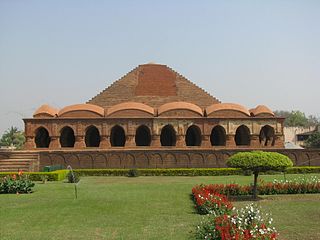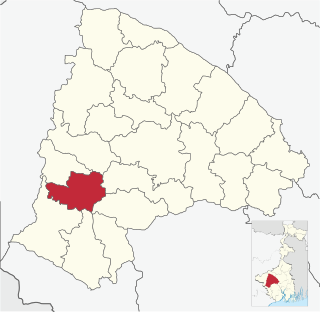This article needs additional citations for verification .(July 2013) |
Tungbhum was the name given to the tract of country lying to the south of Raipur in present Bankura district in the Indian state of West Bengal. [1]
This article needs additional citations for verification .(July 2013) |
Tungbhum was the name given to the tract of country lying to the south of Raipur in present Bankura district in the Indian state of West Bengal. [1]
Tung Deo, who came from the banks of Gandaki River on a pilgrimage to Jagannath, was made king of Puri by favour of Jagannath. His grandson Gangadhar Tung was informed by Jagannath that after him there would no king of Puri in his line. Therefore, his son should change his name and go to some other country where he would be king. [1]
Gangadhar Tung’s son, Nukur Tung, left Puri with his wife, his treasure, and some soldiers in 1448 AD and after wandering for a decade settled in Tikarpara, a village near Shyamsundarpur. At that time the area, called Rajagram, comprised Shyamsundarpur, Phulkusma, Raipur, Simlapal, and Bhalaidiha. The area was earlier ruled by Samantasar Raja, who was destroyed with his family in a fire. The area remained without a king and was overrun by robbers. Nukur Tung subdued the robbers and became king on assuming the name of Raja Chhatra Narayan Deb. He called his kingdom Jagannathpur. The Raja brought with him 252 families of Utkal Brahmins, whose descendants are numerous in the region. [1]
The Raja made a grant of Simplapal and Bhalaidaha parganas to Sripati Mahapatra, his spiritual guide and general during the campaign. Raipur pargana was given as grant to a member of the Sikhar Raj family. Subsequently, as a result of a family dispute, the estate was divided into Shyamsundarpur and Phulkusma. [1]

Bankura district is an administrative unit in the Indian state of West Bengal. It is part of Medinipur division—one of the five administrative divisions of West Bengal. Bankura district is surrounded by Purba Bardhaman district and Paschim Bardhaman district in the north, Purulia district in the west, Jhargram district and Paschim Medinipur district in the south, and some part of Hooghly district in the east. Damodar River flows in the northern part of Bankura district and separates it with the major part of Burdwan district. The district head quarter is located in Bankura town.

Raipur is a community development block that forms an administrative division in the Khatra subdivision of the Bankura district in the Indian state of West Bengal.

Khatra subdivision is a subdivision of the Bankura district in the state of West Bengal, India.

Panchmura is a gram panchayat under Taldangra intermediate panchayat, in Khatra subdivision of Bankura district in the Indian state of West Bengal. It is 21 km (13 mi) from Bishnupur and is famous for the terracotta Bankura horse, a folk artefact and now the national symbol for Indian handicrafts. Recently, a local businessman Bhajan Dutta, established a beautiful temple called Tridhara Milan Mandir which is a miniature of Vrindavan. The temple was established on July 1, 2022 and currently serves over 2000 people daily. Panchmura is completely covered with beautiful forests and nurseries.

History of Bankura district refers to the history of the present Bankura district in the Indian state of West Bengal. Historically, the region was under the realm of Rarh in ancient Bengal.

Dhalbhum was estate in early modern period and British India, spreaded across the East Singhbhum district in present-day Jharkhand, western part of Bankura, and Midnapore district of West Bengal.
Jhilimili is a tourist centre in the Ranibandh CD block in the Khatra subdivision of the Bankura district in the Indian state of West Bengal.

Patachitra or Pattachitra is a general term for traditional, cloth-based scroll painting, based in the eastern Indian states of Odisha, West Bengal and parts of Bangladesh. Patachitra artform is known for its intricate details as well as mythological narratives and folktales inscribed in it. Pattachitra is one of the ancient artworks of Odisha, originally created for ritual use and as souvenirs for pilgrims to Puri, as well as other temples in Odisha. Patachitras are a component of an ancient Bengali narrative art, originally serving as a visual device during the performance of a song.

Chuar rebellion, also called the Chuar Bidroha was a series of peasant movements between 1766 and 1834 by the tribal inhabitants of the countryside surrounding the Jungle Mahals settlements of Dhalbhum, Midnapore, Bankura and Manbhum against the rule of the East India Company (EIC).
Indpur is a village in the Indpur CD block in the Khatra subdivision of the Bankura district in the state of West Bengal, India.

Khatra is a community development block that forms an administrative division in the Khatra subdivision of the Bankura district in the Indian state of West Bengal.
Raipur, referred to in census reports as Raipur Bazar, is a census town in the Raipur CD block in the Khatra subdivision of the Bankura district in the state of West Bengal, India.

The Sheoraphuli Raj Debuttar Estate or Sheoraphuli Rajbari was part of the Zamindari of the Sheoraphuli Raj, a branch of the erstwhile Patuli Rajbansha which occupies a very high place in the peerage of Bengal. The Calcutta Review for 1845 states the Sheoraphuli family is "descended from one of the most ancient and respected families in Bengal".
Phulkusma is a village and a gram panchayat in the Raipur CD block in the Khatra subdivision of the Bankura district in the state of West Bengal, India.
Baragari is a village in PO Jambani and the Raipur CD block in the Khatra subdivision of the Bankura district in the state of West Bengal, India
Kharigerya is a village in the Raipur CD block in the Khatra subdivision of the Bankura district in the state of West Bengal, India
Laugram is a village and a gram panchayat in the Kotulpur CD block in the Bishnupur subdivision of the Bankura district in the state of West Bengal, India.
Matgoda is a small town and a gram panchayat in the Raipur CD block in the Khatra subdivision of the Bankura district in the state of West Bengal, India.
The Bhumij Rebellion, also known as Jungle Mahal Uprising or Ganga Narain's Hungama was a revolt during 1832–1833 by Bhumij tribals based in the Dhalbhum and Jungle Mahal areas of the Midnapore district of the erstwhile Bengal state. It was led by Ganga Narayan Singh.
Durjan Singh was a great leader of Chuar Rebellion of Bengal. Singh was a zamindar of Raipur in the Bishnupur district of Bengal. He led the Chuar Rebellion in 1798–99 in Midnapore district against the British East India Company.